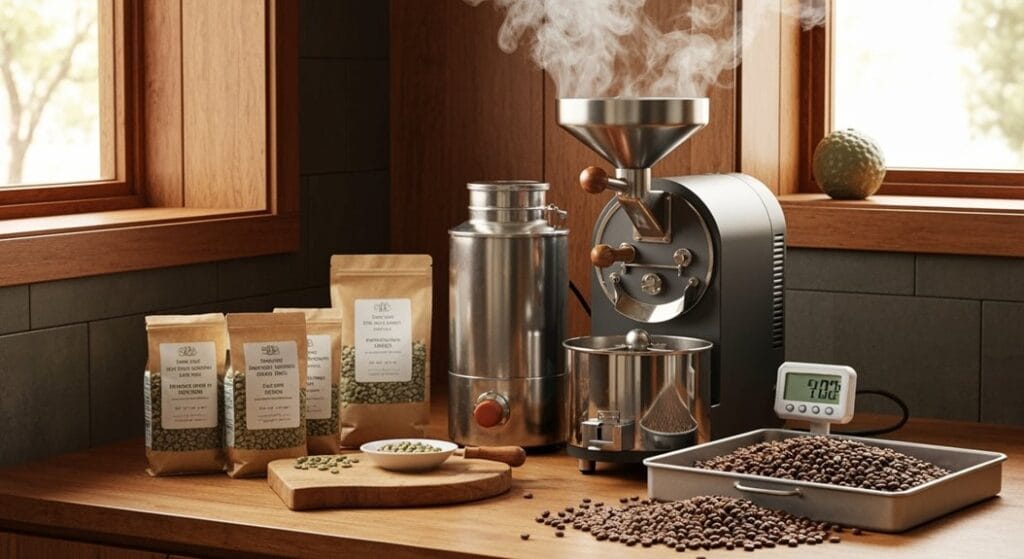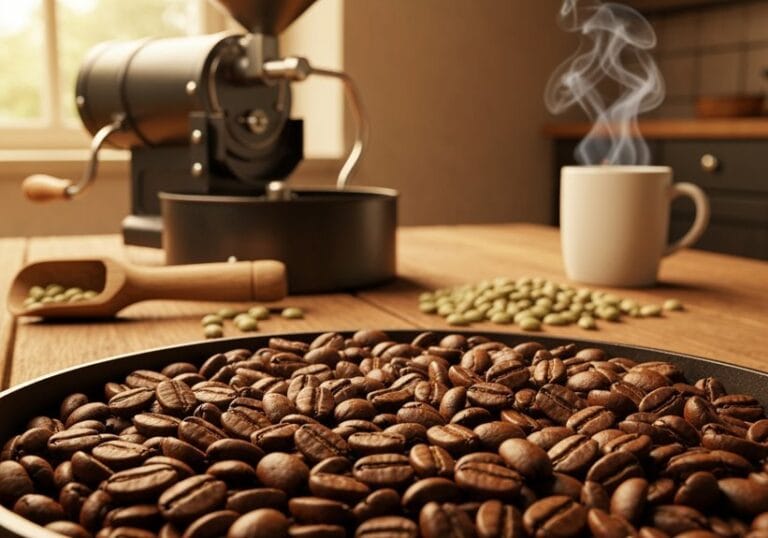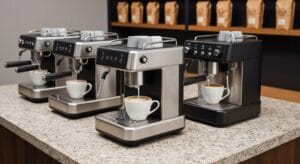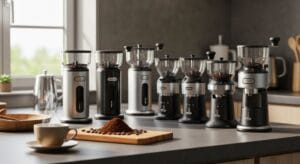Roasting coffee beans at home? It’s like a magic show for your taste buds! Initially, understand the three stages: drying, roasting, and cooling. Seriously, mastering temperature is key! You can use a fancy drum roaster or just a simple pan (if you’re feeling adventurous). Timing is everything, so listen for those delightful cracks like popcorn popping! But wait, the best part? The smell! It’s like a cozy hug! Stick around, there’s so much more to uncover.
Key Takeaways
- Select appropriate equipment based on batch size; fluid-air roasters are ideal for small batches, while drum roasters suit larger loads.
- Preheat your roaster to around 350°F to ensure effective moisture evaporation during the drying stage.
- Monitor roasting time carefully: aim for 4-6 minutes for light roasts and 12-20 minutes for dark roasts.
- Listen for the cracking sounds during roasting to gauge the progress and determine your desired roast level.
- Enjoy the freshest flavor by brewing with ground beans within two weeks of roasting for optimal taste and antioxidants.
Understanding the Roasting Process
In the domain of roasting coffee, there are three main stages you really need to know about—think of them as the trio of coffee magic.
Initially is the drying phase, where temperature control is crucial for effectively evaporating moisture from the green beans.
Choosing the Right Equipment
Choosing the right equipment can feel like a challenging task, especially when every gadget promises to be the key to that perfect cup of coffee.
Selecting the right coffee equipment can be daunting, with each gadget claiming to brew your ideal cup.
So, roaster types! You’ve got fluid-air roasters, like the Fresh Roast SR540, which are great for beginners but only handle small batches—try cramming in more than 120 grams and you might end up with coffee confetti.
Then there are drum roasters that can tackle larger loads, like the Gene Café, which might make you feel like a real coffee wizard!
But remember, bigger is not always better. Capacity considerations matter—if you’re brewing for a coffee-loving crowd, you’ll want something that can roast up to 300 grams, or you’ll be stuck roasting in shifts! Additionally, consider the roasting method since it greatly influences the flavor profile of your coffee.
Tips for Achieving the Perfect Roast

Once the equipment is set up and ready to roast, the real fun begins!
Initially, temperature control is critical—seriously, don’t mess it up! Think of preheating like warming up for a game; you wouldn’t plunge into the pool without a splash, right? Aim for around 350°F at the beginning and then ease up to keep an even roast.
And let’s talk roast timing! Light roasts are quick—4-6 minutes, while dark roasts could take a cool 12-20. Remember, it’ll sound like popcorn popping during those initial cracks!
Just don’t burn anything. Keep stirring like you’re trying to win an award for most enthusiastic whisking. It’s all about that balance, folks! A good roast will enhance the flavors of your coffee beans and highlight their unique characteristics.
Enjoy the process, and may the beans be ever in your flavor!
Enjoying Your Freshly Roasted Coffee
How does one truly savor the experience of freshly roasted coffee?
Envision this: as the aroma wafts through the air, it begs to be brewed! Choosing the right brewing techniques is essential—French press, pour-over, or espresso—all bring out different flavor profiles. Did you know that the brew method significantly affects the caffeine content in your coffee?
As the rich aroma fills the air, the brewing technique you choose transforms your coffee experience into a delightful flavor journey.
And let’s be honest, freshly ground beans just seem to taste better! Grinding them right before brewing releases that punchy flavor and delightful aroma.
But remember, like that one pair of pants you swear you’ll fit into, coffee freshness fades fast. Aim to drink it within two weeks for maximum antioxidants! Excessive caffeine consumption can elevate blood pressure and trigger anxiety.
It’s like a party for your taste buds—flavor explosions galore! (And maybe throw in a good book or some jazz, because life’s too short for sad coffee!) Additionally, consider using immersion brewing methods like the French Press or AeroPress to achieve a more forgiving and flavorful extraction for your freshly roasted beans.
Frequently Asked Questions
Can I Roast Coffee Beans in a Regular Oven?
Yes, one can roast coffee beans in a regular oven by adjusting oven settings to preheat around 215°C. Ideal roasting times range from 10 to 15 minutes for achieving desired roast levels effectively.
How Long Can Homemade Roasted Beans Be Stored?
Homemade roasted beans maintain ideal freshness duration for about one week after opening. Proper storage methods, such as using airtight containers in a cool, dark place, can extend their usability up to one year when sealed.
What’s the Best Way to Grind Roasted Beans?
The best way to grind roasted beans involves using burr grinders for consistent grind size. Adjusting grind size based on brewing methods and incorporating different grinding techniques improves flavor extraction and optimizes the coffee brewing experience.
Can I Mix Different Bean Types While Roasting?
Mixing different bean types while roasting can complicate flavor profiles due to uneven roasting. A preferred roasting technique involves roasting beans separately to optimize their characteristics, allowing for better flavor balance and consistency in blends.
How Can I Tell if My Roast Is Too Dark?
To determine if a roast is too dark, one can inspect color indicators for excessive darkness and oiliness, and evaluate the flavor profiles for burnt, ashy notes that overshadow any desired complexities or sweetness.
References
- https://phys.org/news/2024-12-scientists-roasting-affects-brew.html
- https://pmc.ncbi.nlm.nih.gov/articles/PMC7684626/
- https://pmc.ncbi.nlm.nih.gov/articles/PMC4554650/
- https://engineering.ucdavis.edu/news/engineers-guide-coffee-bean-brew
- https://www.youtube.com/watch?v=1bxOv5N8yyY
- https://benchmarkcoffeetraders.com/sights-scents-subtle-sounds-and-the-different-stages-of-coffee-roasting/
- https://www.barschool.net/blog/coffee-roasting-process





